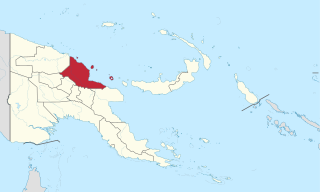
Sandaun Province is the northwesternmost mainland province of Papua New Guinea. It covers an area of 35,920 km2 and has a population of 248,411. The capital is Vanimo. In July 1998 the area surrounding the town of Aitape was hit by an enormous tsunami caused by a Magnitude 7.0 earthquake which killed over 2,000 people. The five villages along the west coast of Vanimo towards the International Border are namely; Lido, Waromo, Yako, Musu and Wutung.

Madang is a province of Papua New Guinea. The province is on the northern coast of mainland Papua New Guinea and has many of the country's highest peaks, active volcanoes and its biggest mix of languages. The capital is the town of Madang.

Chimbu, more frequently spelled Simbu, is a province in the Highlands Region of Papua New Guinea. The province has an area of 6,112 km2 and a population of 376,473. The capital of the province is Kundiawa. Mount Wilhelm, the tallest mountain in Papua New Guinea is on the border of Eastern part of Simbu and the Western part of Madang Province.

Western Highlands is a province of Papua New Guinea. The provincial capital is Mount Hagen. The province covers an area of 4,299 km2, and there are 362,850 inhabitants, making the Western Highlands the most densely populated province. Tea and coffee are grown in the Western Highlands.

Eastern Highlands is a highlands province of Papua New Guinea. The provincial capital is Goroka. The province covers an area of 11,157 km2, and has a population of 579,825. The province shares a common administrative boundary with Madang Province to the north, Morobe Province to the east, Gulf Province to the south, and Simbu Province to the west. The province is the home of the Asaro mud mask that is displayed at shows and festivals within the province and in the country. The province is reachable by air, including Goroka Airport, and road transport, including the main Highlands Highway.

Southern Highlands is a province in Papua New Guinea. Its provincial capital is the town of Mendi. According to Papua New Guinea's national 2011 census, the total population of Southern Highlands is 515,511 spread across 15,089 square kilometers (5,826 sq mi).

East Sepik is a province in Papua New Guinea. Its capital is Wewak. East Sepik has an estimated population of 433,481 people and is 43,426 km square in size.

Central Province is a province in Papua New Guinea located on the southern coast of the country. It has a population of 237,016 people and is 29,998 square kilometres (11,582 sq mi) in size. The seat of government of Central Province, which is located within the National Capital District outside the province, is the Port Moresby suburb of Konedobu. On 9 October 2007, the Central Province government announced plans to build a new provincial capital city at Bautama, which lies within Central Province near Port Moresby, although there has been little progress in constructing it.

This page is a list of districts of Papua New Guinea.

Hela is a province of Papua New Guinea. The provincial capital is Tari. The province covers an area of 10,498 km², and there are 249,449 inhabitants. Hela province officially came into being on 17 May 2012, comprising three districts previously part of Southern Highlands Province.
Kup Rural LLG is one of the Local Level Government of Kerowagi District in the Chimbu Province, Papua New Guinea.
South Waghi Rural LLG is a local-level government (LLG) of Jiwaka Province, Papua New Guinea.
Lai Valley Rural LLG - Kulia 741 is a local-level government (LLG) of Southern Highlands Province, Papua New Guinea.
Nembi Plateau Rural LLG is a local-level government (LLG) of Southern Highlands Province, Papua New Guinea. The Nembi language is spoken in the LLG.
Mul Rural LLG is a local-level government (LLG) of Western Highlands Province, Papua New Guinea.
Anglimp Rural LLG is a local-level government (LLG) of Jiwaka Province, Papua New Guinea.
Jimi Rural LLG is a local-level government (LLG) of Jiwaka Province, Papua New Guinea.
Kol Rural LLG is a local-level government (LLG) of Jiwaka Province, Papua New Guinea.
North Waghi Rural LLG is a local-level government (LLG) of Jiwaka Province, Papua New Guinea.
Nondugl Rural LLG is a local-level government (LLG) of Jiwaka Province, Papua New Guinea.











